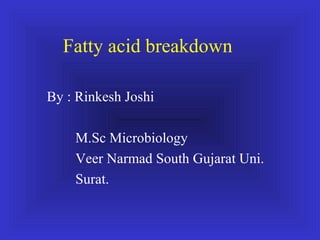
fatty acid breakdown
- 1. Fatty acid breakdown By : Rinkesh Joshi M.Sc Microbiology Veer Narmad South Gujarat Uni. Surat.
- 2. Fatty acid breakdown • The oxidation of fatty acids proceeds in three stages
- 3. β-oxidation ∀ β-oxidation is catalyzed by four enzymes – Acyl-CoA dehydrogenase – Enoyl-CoA hydratase β-hydroxyacyl-CoA dehydrogenase – Acyl-CoA acetyltransferase (thiolase)
- 4. First step • Isozymes of first enzyme confers substrate specificity FAD-dependent enzymes Reaction analogous to succinate dehydrogenase in citric acid cycle
- 5. Electrons on FADH2 transferred to respiratory chain
- 6. Second step Adding water across a double bond Analogous to fumarase reaction in citric acid cycle
- 7. Third step Dehydrogenation (oxidation) using NAD NADH is transferred to respiratory chain for ATP generation Analogous to malate dehydrogenase reaction of citric acid cycle
- 8. Fourth step Splits off the carboxyl-end Acetyl-CoA and replaces it with Co-A – Thiolase
- 9. β-oxidation bottomline • The first three reactions generate a much less stable, more easily broken C-C bond subsequently producing two carbon units through thiolysis
- 10. The process gets repeated over and over until no more acetyl-CoA can be generated • 16:0-CoA + CoA + FAD + NAD + H2O 14:0- CoA + acetyl-CoA + FADH2 + NADH + H+ • Then.. • 14:0-CoA + CoA + FAD + NAD + H2O 12:0- CoA + acetyl-CoA + FADH2 + NADH + H+ • Ultimately.. • 16:0-CoA + 7CoA + 7FAD + 7NAD + 8H2O 8acetyl-CoA + 7FADH2 + 7NADH + 7H+
- 11. Acetyl-CoA can be fed to the citric acid cycle resulting in reducing power
- 12. Breakdown of unsaturated fatty acids requires additional reactions • Bonds in unsaturated fatty acids are in the cis conformation, enoyl-CoA hydratase cannot work on as it requires a trans bond • The actions of an isomerase and a reductase convert the cis bond to trans, resulting in a substrate for β-oxidation
- 13. In some instances (monounsaturated), enoyl-CoA isomerase is sufficient
- 14. For others (polyunsaturated), both are needed
- 15. Complete oxidation of odd-number fatty acids requires three extra reactions • Although common fatty acids are even numbered, odd numbered fatty acids do occur (ie. propionate) • Oxidation of odd numbered fatty acids uses same pathway as even numbered • However, ultimate substrate in breakdown has five, not four carbons, which is cleaved to form acetyl-CoA and propionyl-CoA
- 16. Propionyl Co-A enters the citric acid cycle using three steps • Propionyl Co-A is carboxylated to form methyl-malonyl CoA (catalyzed by the biotin containing propionyl-CoA carboxylase) • Recall that methyl-malonyl CoA is also a intermediate in the catabolism of methionine, isoleucine, threonine and valine to succinyl-CoA
- 18. Methyl-malonyl-CoA undergoes two isomerization steps to form succinyl-CoA • Methyl-malonyl epimerase catalyzes the first reaction • Methyl-malonyl-CoA mutase (a vitamin B12 dependent enzyme) catalyzes the second to form succinyl-CoA
- 19. Vitamin B12 catalyzes intramoelcular proton exchange
- 20. Vitamin B12 is a unique and important enzyme cofactor • Contains cobalt in a corrin ring system (analogous to heme in cytochrome) • has a 5’ deoxy adenosine (nucleoside component • Has a dimethylbenzimidazole ribonucleotide component
- 22. Attachment of upper ligand is second example of triphosphate liberation from ATP • Cobalamin Coenzyme B12 The other such reaction where this is observed is formation of Ado-Met
- 23. Proposed mechanism for methyl- malonyl CoA mutase • Same hydrogen always accounted for
- 24. Regulation of fatty acid oxidation • Fatty acids in the cytosol can either be used to form triacylglycerols or for β-oxidation • The rate of transfer of fatty-acyl CoA into the mitochondria (via carnitine) is the rate limiting step and the important point of regulation, once in the mitochondria fatty acids are committed to oxidation
- 25. Malonyl-CoA is a regulatory molecule • Malonyl-CoA (that we will talk about in more detail next week in lipid biosynthesis) inhibits carnitine acyltransferase I
- 26. Also… • When [NADH]/[NAD] ratio is high β- hydroxyacyl-CoA dehydrogenase is inhibited • Also, high concentrations of acetyl-CoA inhibit thiolase
- 27. Diversity in fatty acid oxidation • Can occur in multiple cellular compartments
- 28. ∀ β-oxidation in peroxisomes and glyoxysomes is to generate biosynthetic precursors, not energy
- 30. Fatty acids can also undergo ω oxidation in the ER • Omega oxidation occurs at the carbon most distal from the carboxyl group • This pathway involves an oxidase that uses molecular oxygen, and both an alcohol and aldehyde dehydrogenase to produce a molecule with a carboxyl group at each end • Net result is dicarboxylic acids
- 32. Omega oxidation is a minor pathway • Although omega oxidation is normally a minor pathway of fatty acid metabolism, failure of beta-oxidation to proceed normally can result in increased omega oxidation activity. A lack of carnitine prevents fatty acids from entering mitochondria can lead to an accumulation of fatty acids in the cell and increased omega oxidation activity
- 33. Alpha oxidation is another minor pathway
- 34. Ketone bodies are formed from acetyl CoA • Can result from fatty acid oxidation or amino acid oxidation (for a few that form acetyl-CoA)
- 35. Formation of ketone bodies
- 36. Ketone bodies can be exported for fuel
- 37. Then broken down to get energy (NADH)
